
Deposition Date
2007-04-18
Release Date
2007-06-19
Last Version Date
2024-10-09
Entry Detail
PDB ID:
2PKR
Keywords:
Title:
Crystal structure of (A+CTE)4 chimeric form of photosyntetic glyceraldehyde-3-phosphate dehydrogenase, complexed with NADP
Biological Source:
Source Organism:
Spinacia oleracea (Taxon ID: 3562)
Host Organism:
Method Details:
Experimental Method:
Resolution:
2.40 Å
R-Value Free:
0.25
R-Value Work:
0.24
R-Value Observed:
0.24
Space Group:
P 1 21 1


